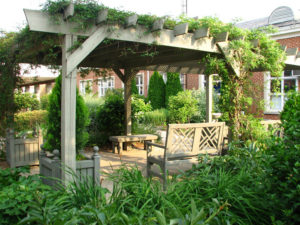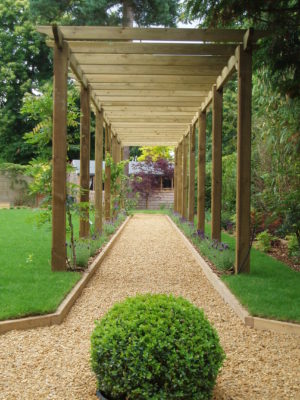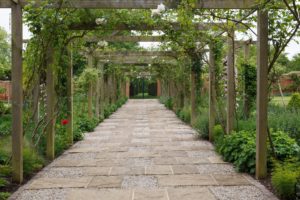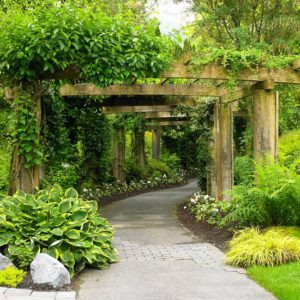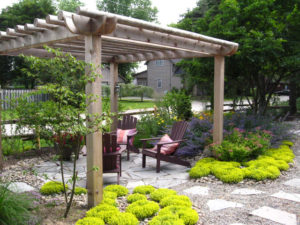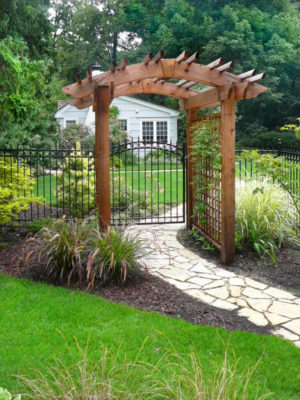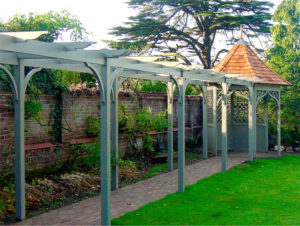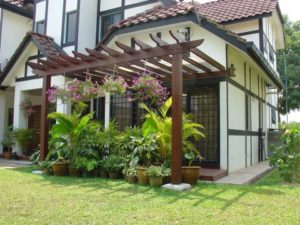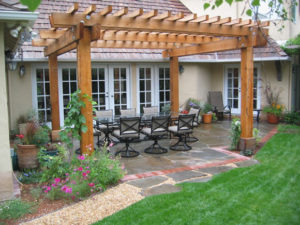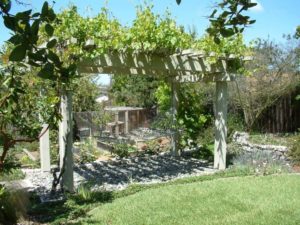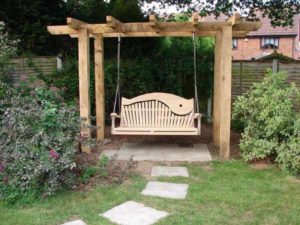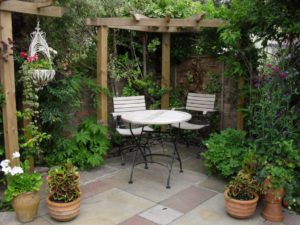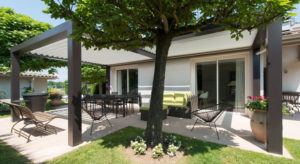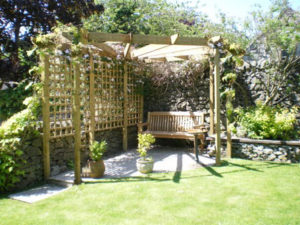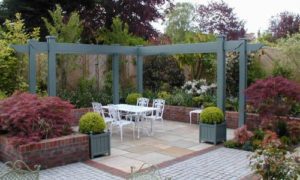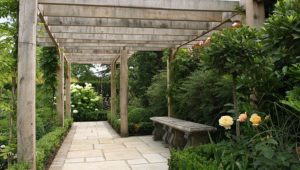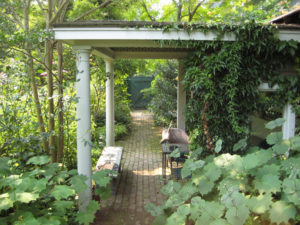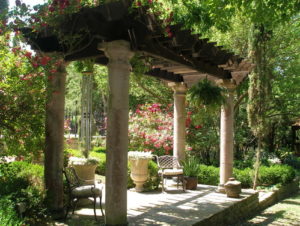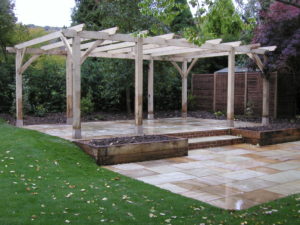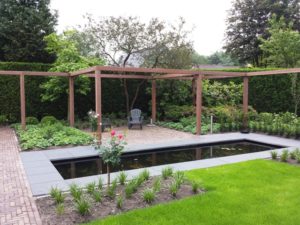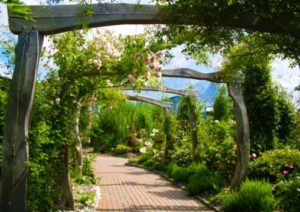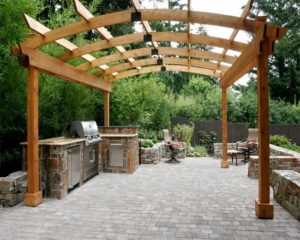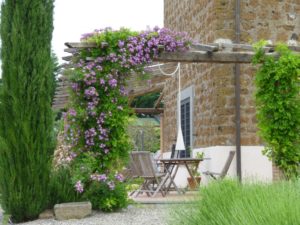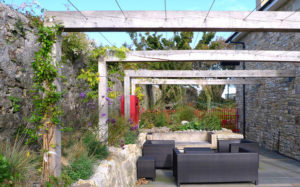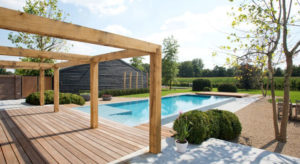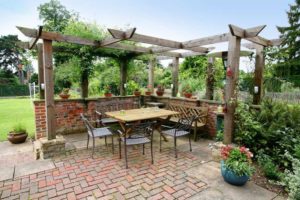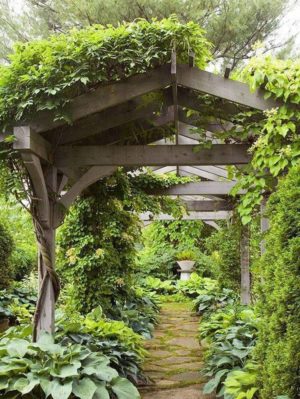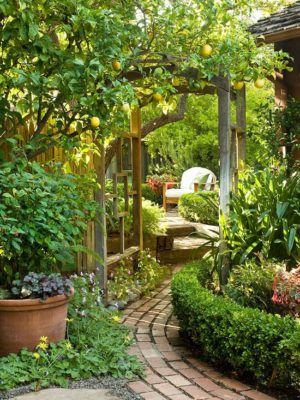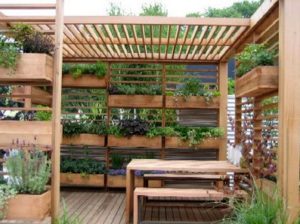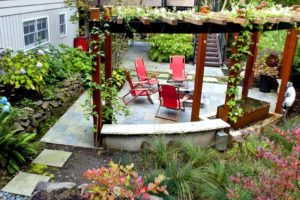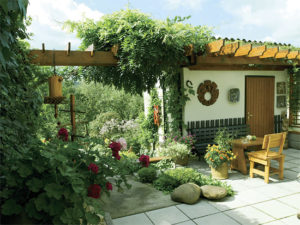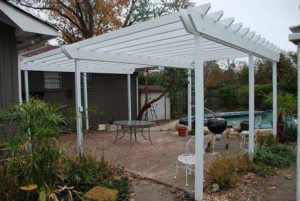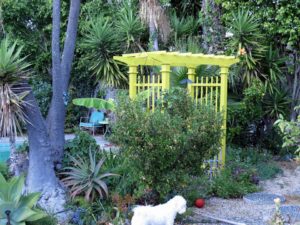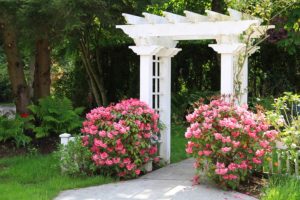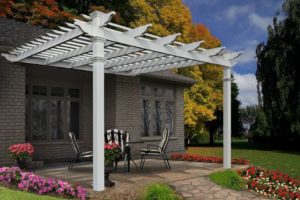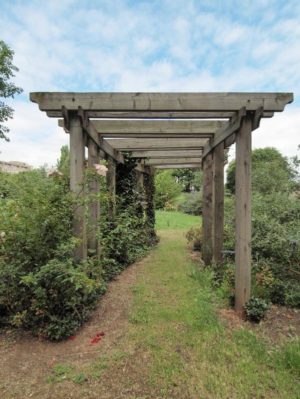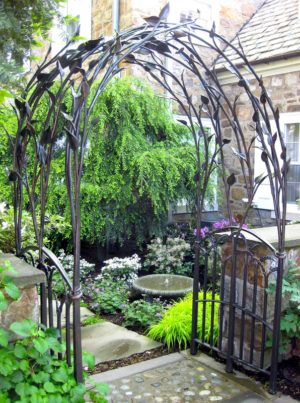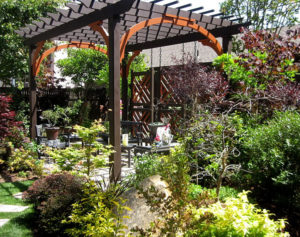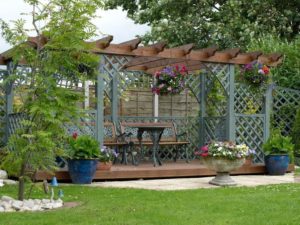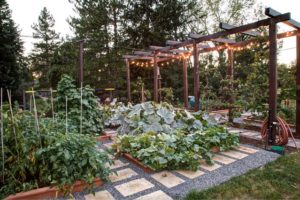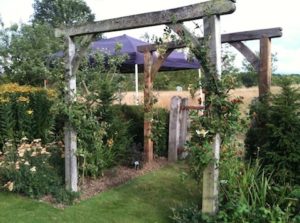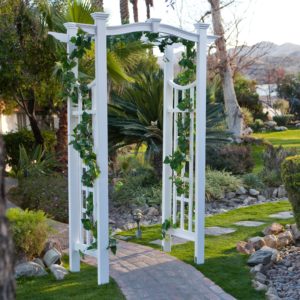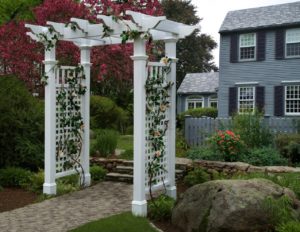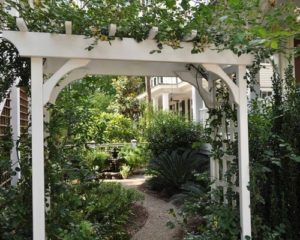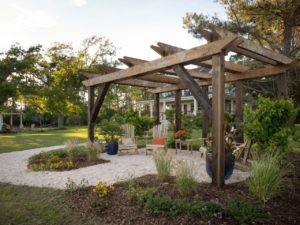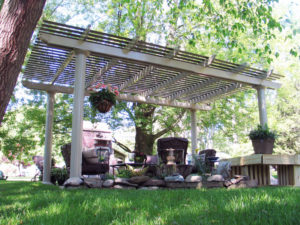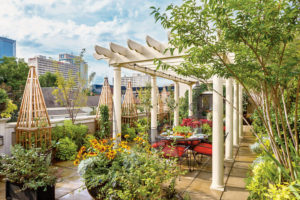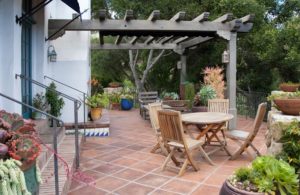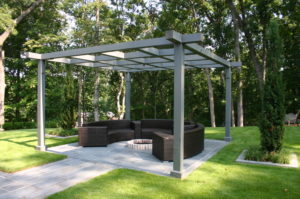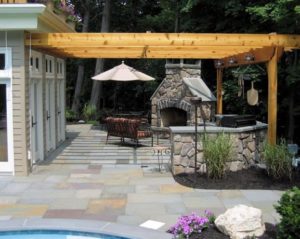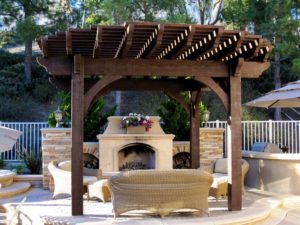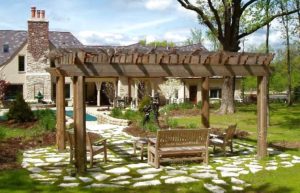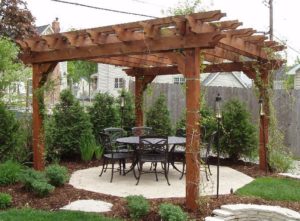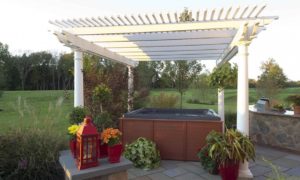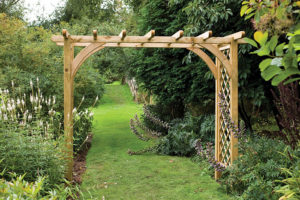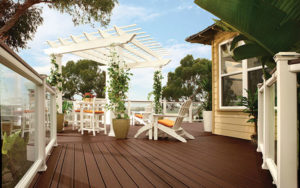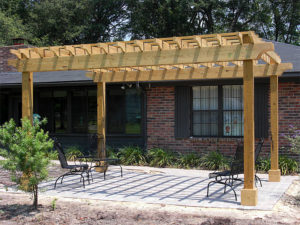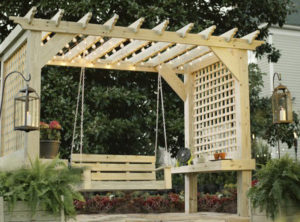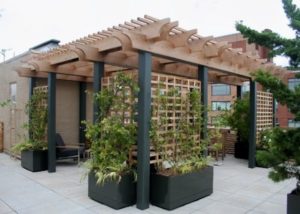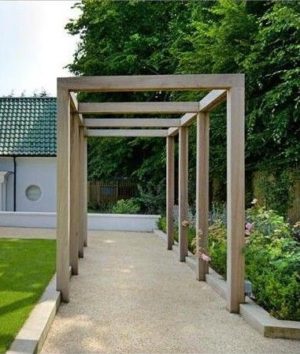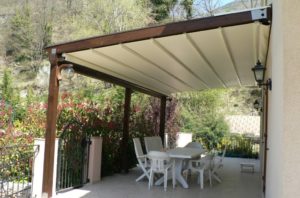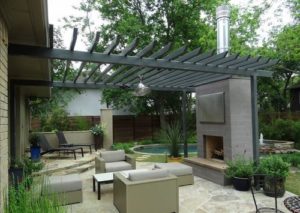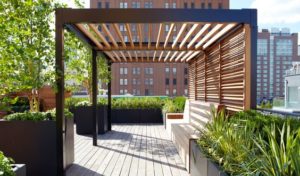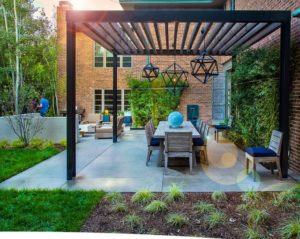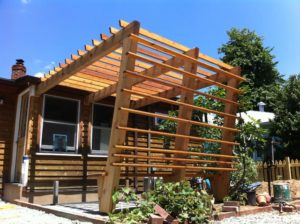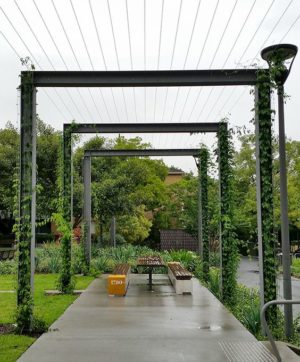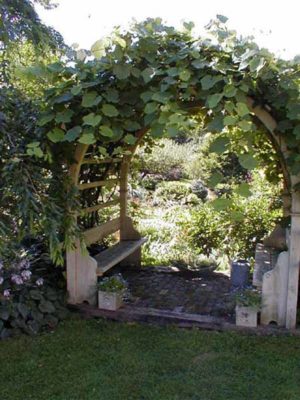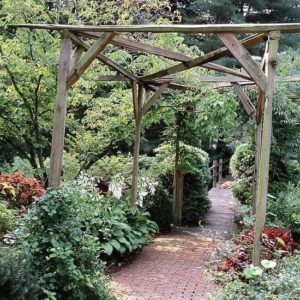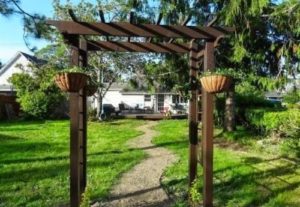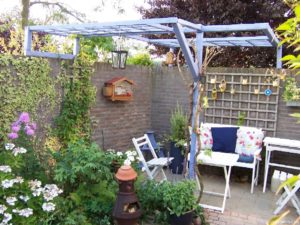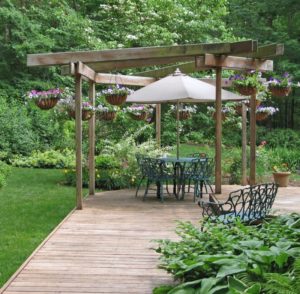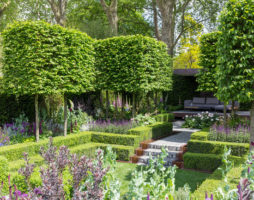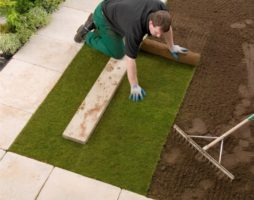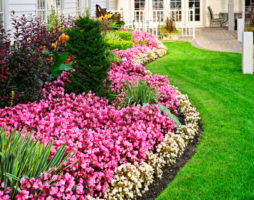The pergola is a charming piece of small lattice architecture that stands out among trellises, berms, arches and simple canopies.
Its distinguishing feature is an unusual appearance, reminiscent of an openwork green corridor with an arched vault leading deep into the garden or a whole green room. A small architectural structure of this type attracts with the brightness of the floristic solution and the non-triviality of the internal atmosphere, which is why garden pergolas have become so popular in the designs of our gardens.

garden pergola
The term itself has Italian roots. In literal translation, "pergola" is interpreted as an extension (canopy). Indeed, such elements of landscape design can either be adjacent to the house itself or be a separate structure. If you look at the object from the inside, it immediately becomes clear that this is not a gazebo, in the usual sense, and not a skeleton for the growth of climbing plants, but a very peculiar type-setting structure of systematically repeating sections, united by transversely laid bars, where every detail: an arch, pillar, column - densely entwined with plants. It may seem to someone that assembling a pergola with your own hands is an unsolvable task, but doesn’t the desire to have a beautiful landscape with an unbroken solution make you delve deeper into the issue?
back to index ↑Functionality of pergolas
Do you really need exotic in the garden? It must be understood that such buildings are not just art objects. They carry a large functional load, so they bring quite practical benefits. In the classic version, do-it-yourself wooden pergolas are assembled from several arches slightly spaced from each other, connected by a lattice ceiling. The elegance of the shape of the building instantly turns the garden path into something mysteriously alluring, calling you to immediately go on an exciting walk through the depths of the garden.
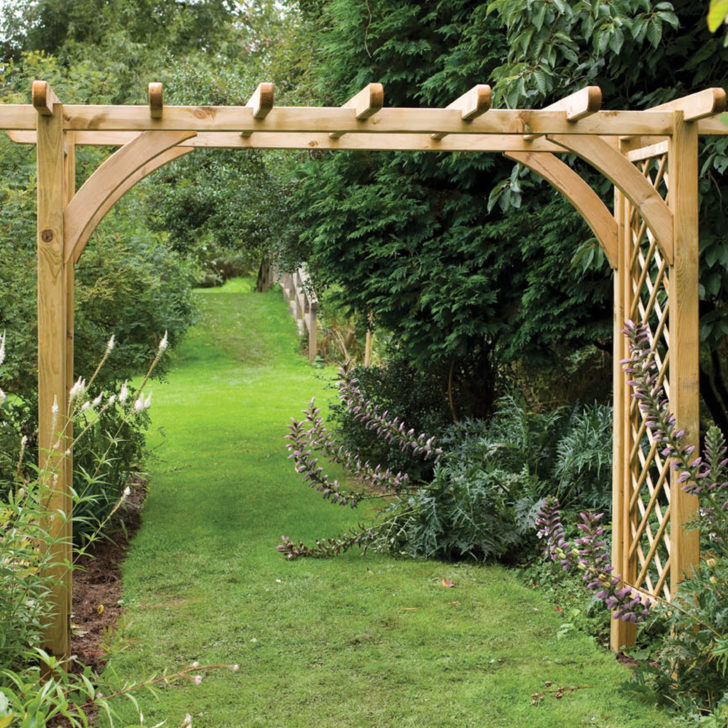
Classic wooden garden pergola
It should be noted that in the Roman Empire, such gazebos did not differ in a variety of designs and were set up solely for the purpose of comfortable growing grapes. The modern choice of forms and decor of openwork corridors made it possible to make them the main elements of the garden, the centers of semantic compositions.
The pergola has several tasks:
1. Making a relaxation zone.
2. Providing coolness.
3. Decoration of the landscape.
This means that the design of garden pergolas must be chosen in accordance with the load placed on them. So you have to decide in order to have a new detail in the garden. A pergola can be an auxiliary building that masks some kind of household object or become a leisure area.
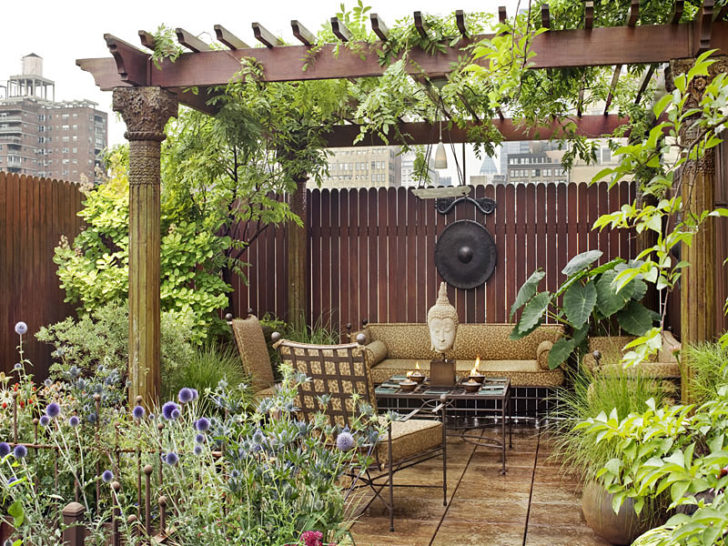
Pergola decorates the recreation area
Although the architectural addition is quite nice, nevertheless, it must be able to fit into the surrounding landscape, especially if these are already inhabited territories, so you will have to think about the shape and stylistic solution of the building. You can find interesting options for collecting pergolas with your own hands in the photo galleries of specialized sites.
back to index ↑Garden pergolas: species diversity
Such a landscape design can be assembled in any form and any size.Naturally, the element must be correlated with the proportions of suburban areas and assembled in an adequate environment and configuration purpose.
Awning
Pergolas of this type are more often adjacent to houses, but they can also be interpreted as a carport for parking a car or arranging a playground. You can assemble a gazebo to demonstrate flowering plants, or approach the design from a purely practical side and assign it the role of the basis for weaving. Awnings will perfectly replace full-fledged gazebos, providing a semi-shaded, wind-blown place for comfortable dinners and evening gatherings. The only drawback of wooden pergolas is the lack of rain protection.
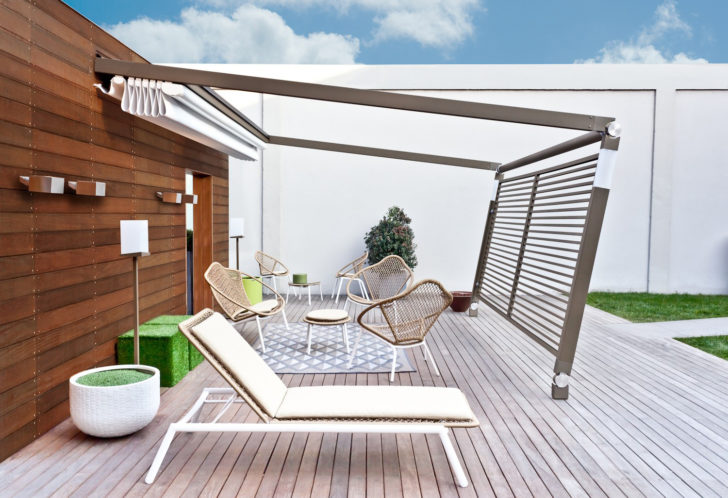
Pergola - awning
Screen
The name already hints at the fact that in such a gazebo it will be possible to hide from unwanted eyes. It’s a good idea to put it along the fences, blocking the neighbors’ view of their territories or use it in zoning space. Such a green wall can very well separate the children's play area from the garden, interpreted in the style of the Victorian era.
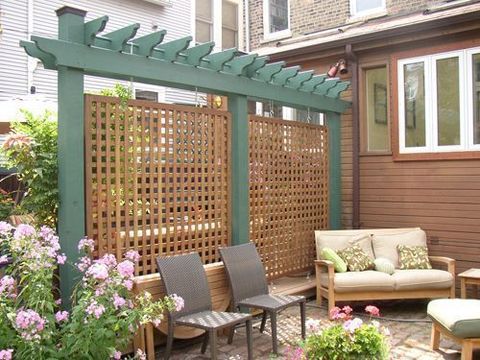
Pergola screen for garden zoning
Visor
Pergola type. preferred by southerners. Almost every house has a canopy, densely braided with grapes, whose task is to shade the windows.
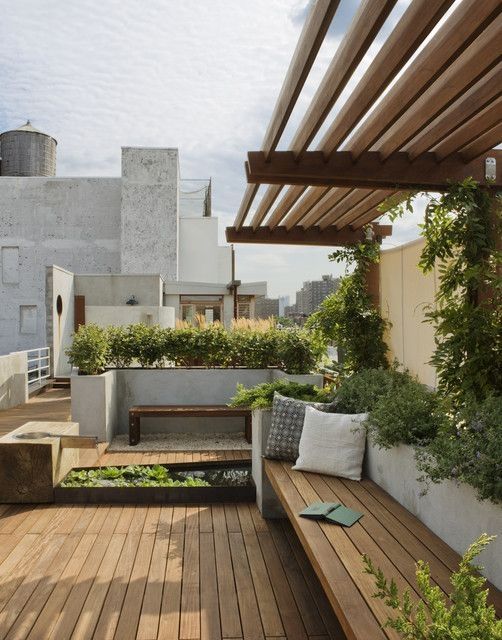
Pergola visor will give coolness on a hot day
Tunnel
The most impressive type of structures. Tunnels are assembled from a certain number of arches, exposed along a common guide. The standard placement is the track. A pergola can become its direct decoration or serve as a screen, hiding something that is not very attractive from view. You can leave behind the scenes a garden or unsightly, but very necessary utility buildings in the household. The form of arches for tunnel garden pergolas is varied, making it easy to fit them into stylish landscapes. A rounded, arched arch will be in demand in an oriental style, a rectangular one, complemented by columns and a roof, is suitable for classics and landscapes a la country.
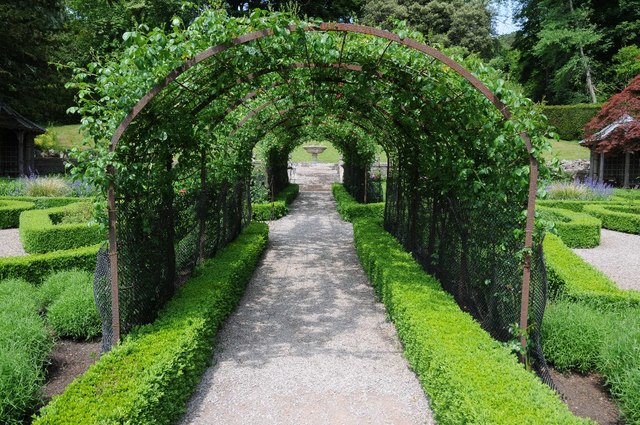
Picturesque pergola tunnel
Now let's talk about texture. Openwork lattice - the design is light and carries with it a romantic mood. It can be placed even in a tiny area, since it does not burden the perception of the landscape. But the stone tunnel is monumental, so it usually adorns spacious estates in medieval and castle styles.
A pergola of any kind, first of all, is an element of landscape design, therefore it should be integrated into the overall ensemble, including being combined with the architecture of the house. Agree, a construction of unplaned poles is unlikely to cause delight if it stands against the backdrop of a minimalist house, but it will only add color to rural-type buildings.
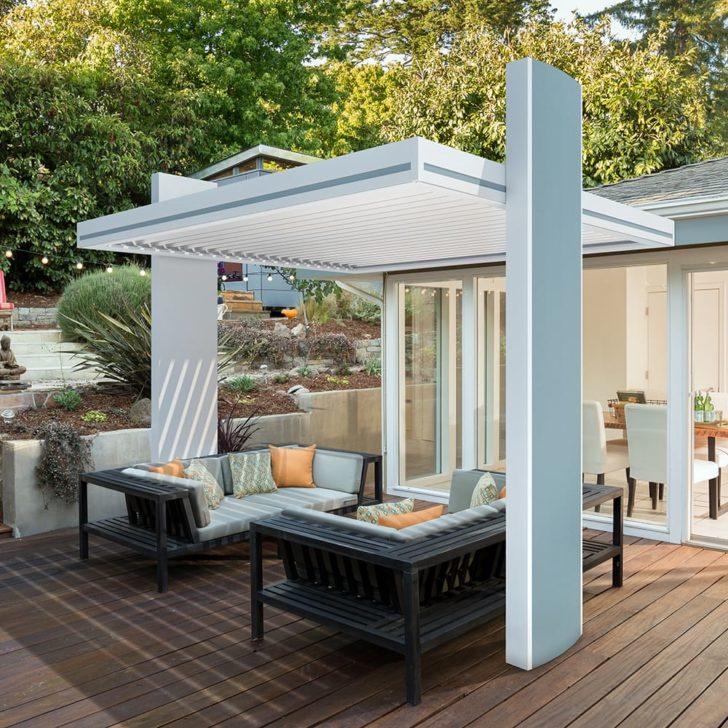
Pergola should be in harmony with the design of the house
Structurally simple wooden pergolas are made from any larch logs and will satisfy the needs of connoisseurs of rustic styles and cottage owners. More complex compositions, including stone columns and carved crossbars, are more suitable for landscapes of estates in the noble style. Such options are expensive and difficult to implement.
back to index ↑Pergola classification
Garden pergolas can be classified into several categories. First of all, in form:
- fan-shaped;
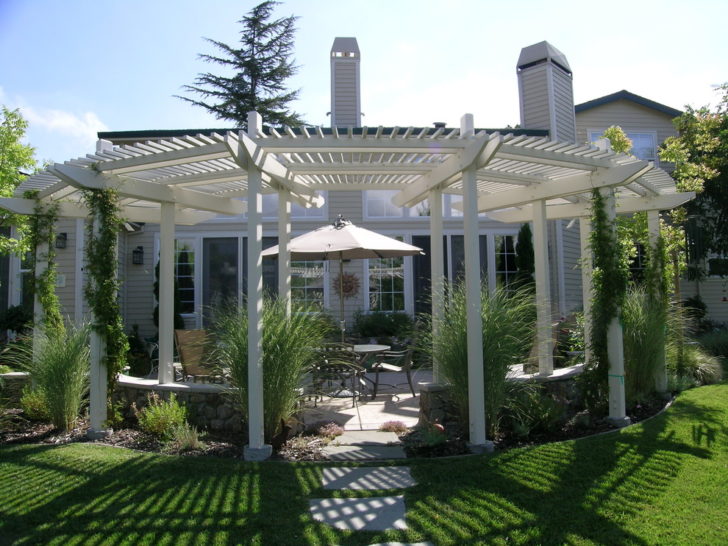
Fan-shaped garden pergola
- rounded;
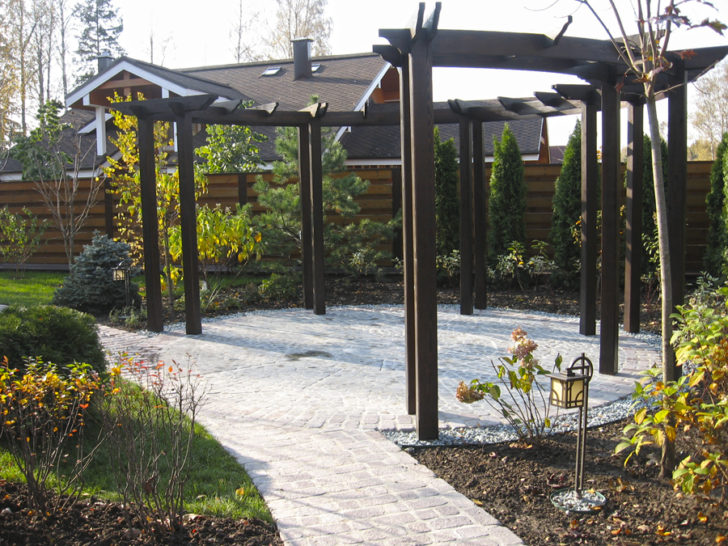
Round pergola
- with breaks.
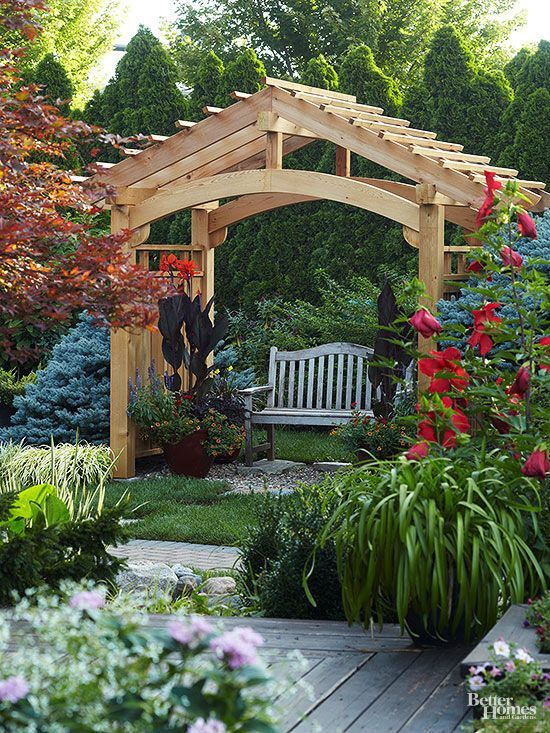
Pergola with kinks
By material:
- wooden;
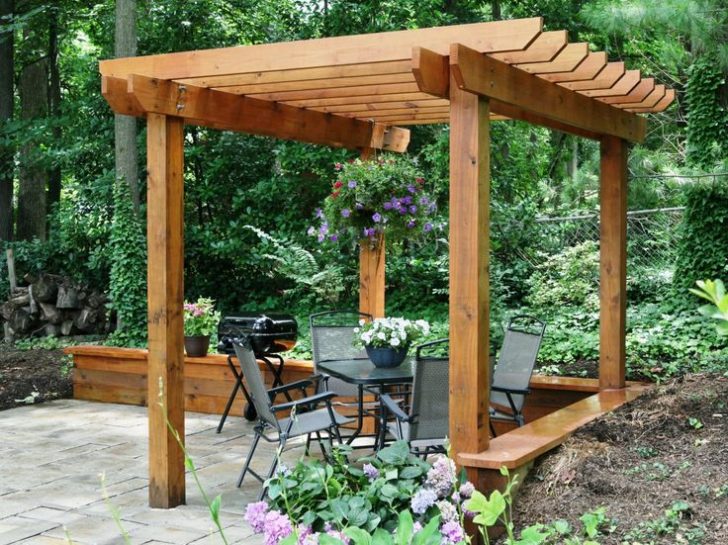
wooden pergola
- plastic;
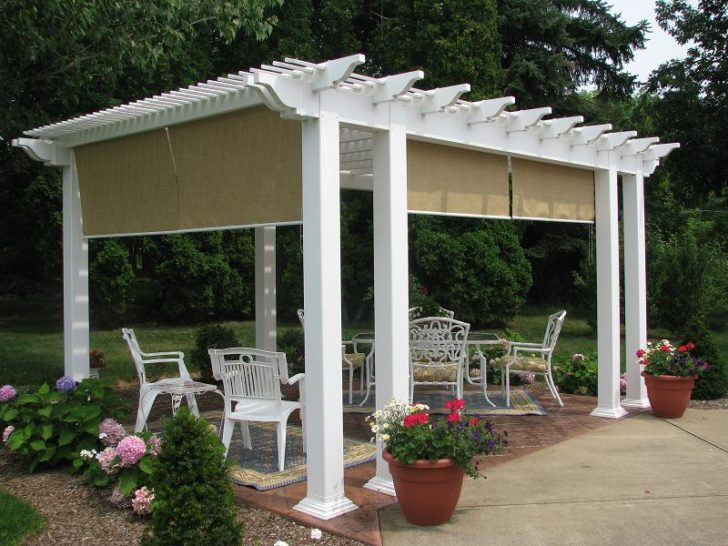
Plastic pergola
- metal;
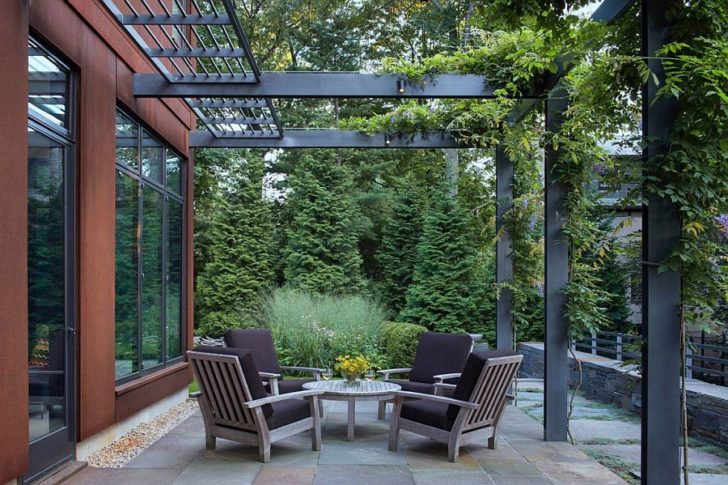
Metal garden pergola
- stone.
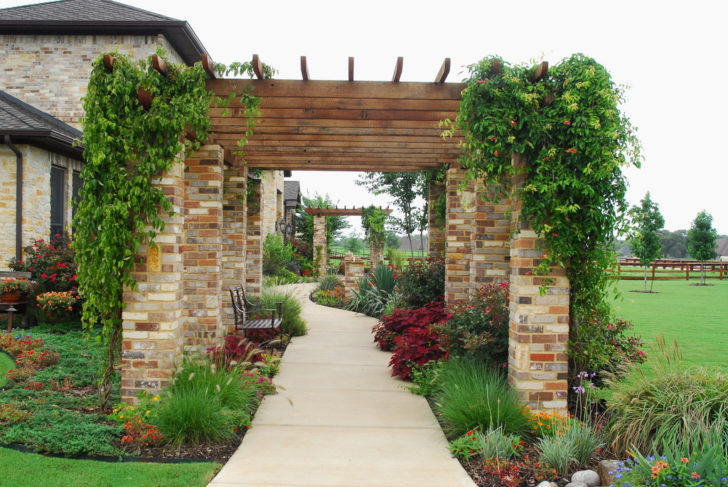
Pergola with brick base
Location type:
- adjoining;
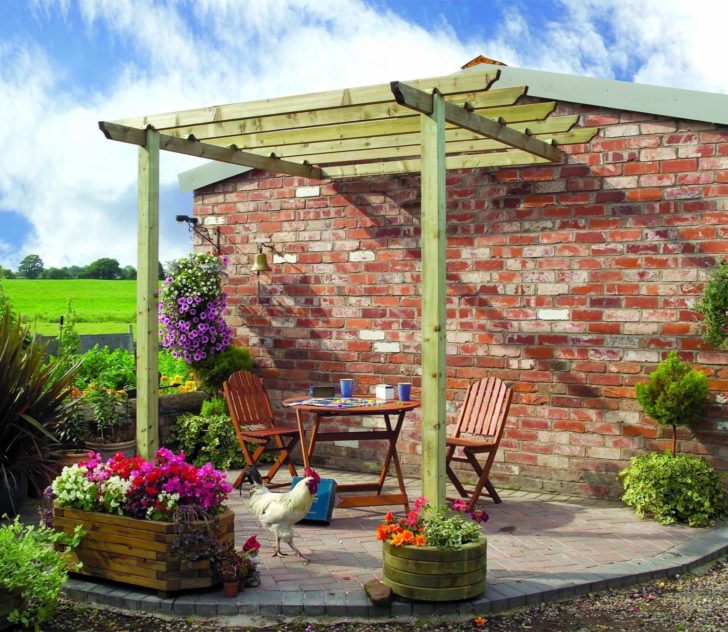
Pergola adjoining the house
- standing individually.
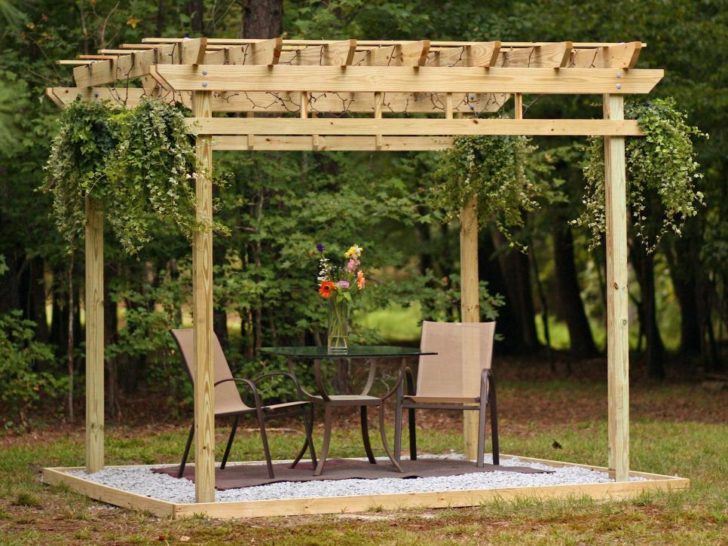
Individual standing pergola
Pergolas can be framed for the stage, swings, auditorium, barbecue area, benches. It has become a popular technique to build several garden pergolas at once and install them at a short distance.Using a broken trajectory of placement, you can interestingly arrange the transitions between them, alternating open paths with alleys going under the arches. Ideal for non-standard spatial solutions.
back to index ↑DIY wooden pergolas
“When working on an element of a dacha landscape with your own hands, try to choose from projects of garden pergolas that are not the most difficult options to implement”
A winding path under a pergola entwined with roses is a luxurious way to improve the cottage and the opportunity to enjoy walking in the garden. You can go further and complement the design with a full-fledged auditorium, equipping it with benches or organizing a place for meals in it in the spirit of the best traditions of the nobility. When working on an element of a summer cottage landscape with your own hands, try to choose from projects of garden pergolas not the most difficult options to implement. It is desirable that they are assembled from a material that is easy to use.
You can quickly put up single-row pergolas on your own. The process is intuitive. All that is needed is to lay the crossbeam on the dug-in beams and secure it well.
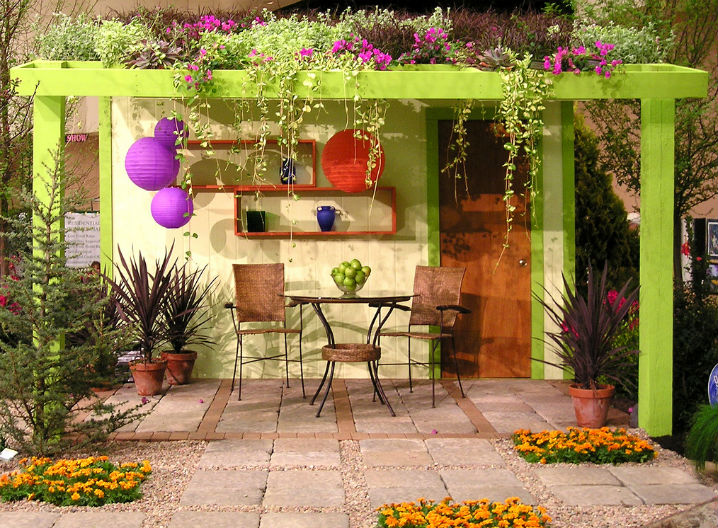
Simple single row pergola
More interesting are dynamic or directional wooden pergolas, which serve as a kind of portal between spaces of various purposes.
Take a closer look at static models, which can be both wall-mounted and free-standing objects. In the first case, the work will be half as much, since one of the supports will already be ready. Horizontal beams on one side will be attached to the wall of the house itself.
Stone, wood, metal?
Building a pergola with your own hands is most comfortable, of course, from wood. This does not mean at all that a simple board will be used in the work. You can refuse cheap lumber and make structural elements from precious wood, decorating them with additional intricate carvings. Very good garden pergolas:
- from larch,
- acacia,
- oak,
- pines.
Gazebos with birch supports look interesting.
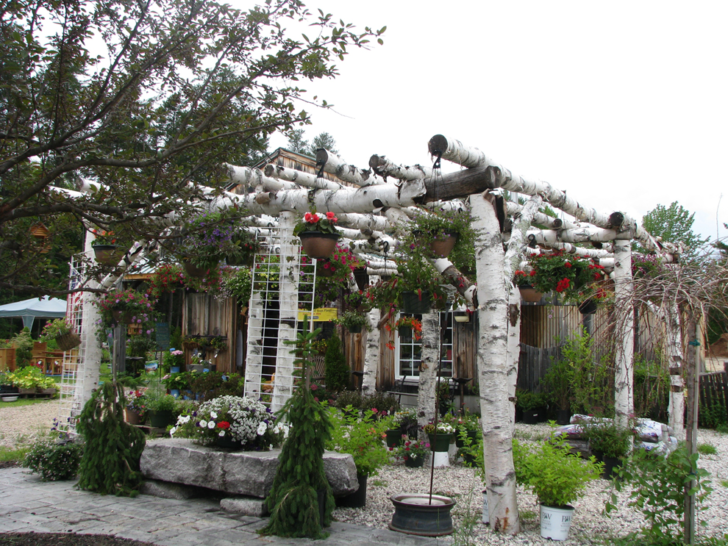
Pergola with birch supports
It doesn't matter what kind of tree you choose. It must be perfectly dried and undergo high-quality antiseptic treatment. In the future, you will have to repeat similar procedures to extend the life of wooden garden pergolas, at least once a year.
How to determine the size of a pergola
When deciding what dimensions your gazebo should have, do not go to extremes. A low and narrow option will be lost in the general background and will never become something attractive. Too spacious, it will be difficult to plant greenery and give it a finished look.
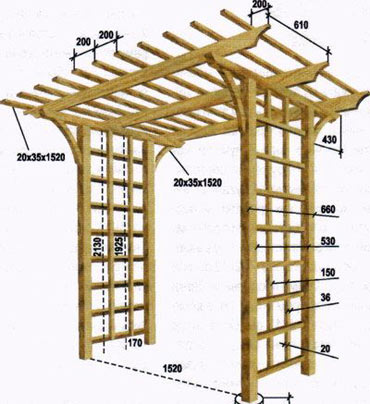
Dimensions of a standard pergola
The height of the structure recommended by experts ranges from 2.3 to 2.5 meters. The installation width of the supports is determined as 1 - 1.5 meters. There are no restrictions regarding the length. In this regard, you can embody any design ideas.
Plant selection
It is green spaces that transfer garden pergolas from the category of inanimate structures to the category of natural art objects, so they must be chosen correctly. A zealous owner, of course, uses the supports and beams of the gazebo for growing grapes of various varieties. It will turn out both beautiful and tasty. In addition to grapes, such vines as hops, beans, and Chinese magnolia vine can also bear fruit. Women are more likely to give preference to clematis, morning glory, English ivy, wisteria and, of course, fragrant and luxurious roses.
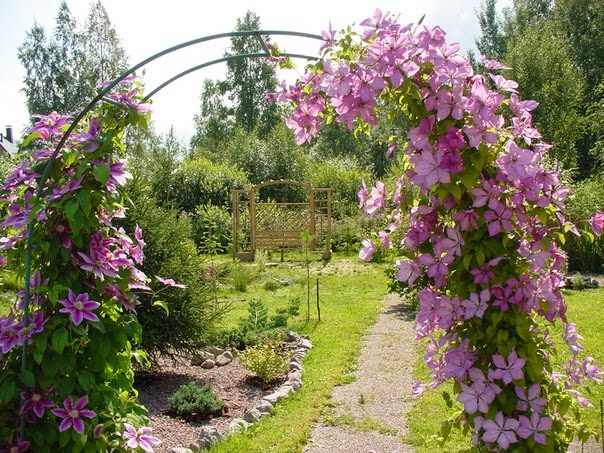
Garden pergola entwined with clematis
Construction stages
Do-it-yourself pergola construction includes:
1. Work on the construction of the structure itself.
2. Works on landscaping of the created object.
Both processes are interrelated and therefore cannot be considered separately.If there is a defect in the structure, then it will not be possible to aesthetically landscape it, if there are problems with landscaping, then instead of the expected art object, only a strange building will appear on the site, in no way adapted to the surrounding landscape. If this is your first time doing such a thing, then it is better to try your hand at building wooden garden pergolas on four pillars.
What will be needed?
Prepare several trellis panels, six massive beams (for supports and side beams) and four thinner ones (for crossbars). You will need nails, screws, roofing material, a shovel, a trowel, a hammer, a chisel and a container for mixing the solution. Of the measuring tools involved in the work: level, plumb and tape measure.
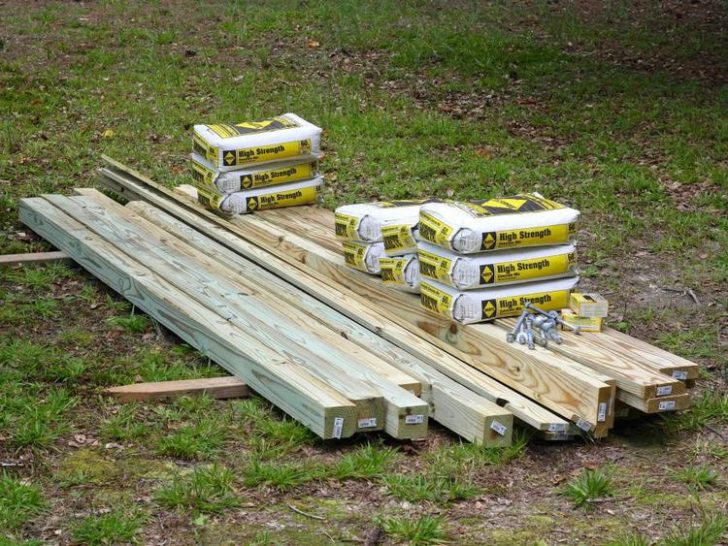
Materials for building a pergola
Attention, let's start!
Step 1. We draw a plan for the future pergola. You should not make its height over 2.5 m. In strong winds, the wooden frame may lose its stability.
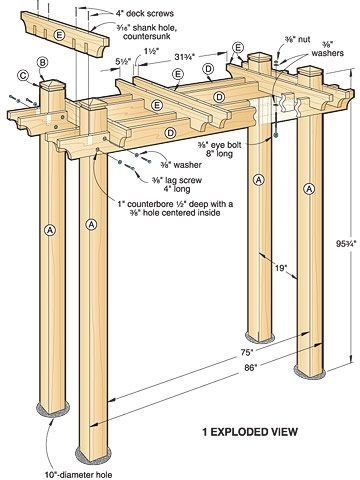
Pergola drawing
Step 2 Site marking. We break the site according to the plan and determine the places for installing the pergola support beams. Since they are fixed by concreting, you will have to dig holes in the amount of 4 pieces, with a recess in the ground of at least 60 cm and a side length of 40 cm.
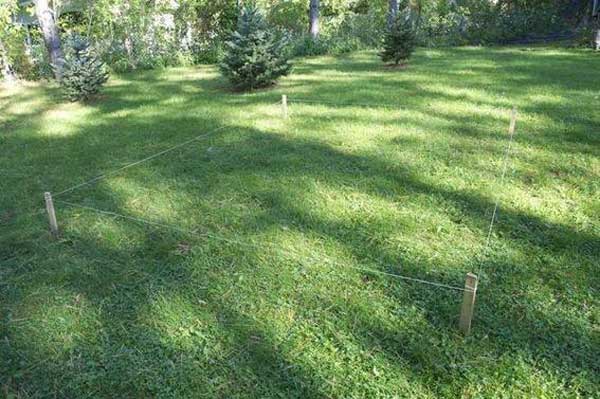
Site marking
Step 3 Installing poles. We wrap the base of the support beams with roofing material and immerse them in the prepared pits. We determine the verticality of the supports with a plumb line and fill the pits with concrete. Work stops until the foundation is completely solidified.
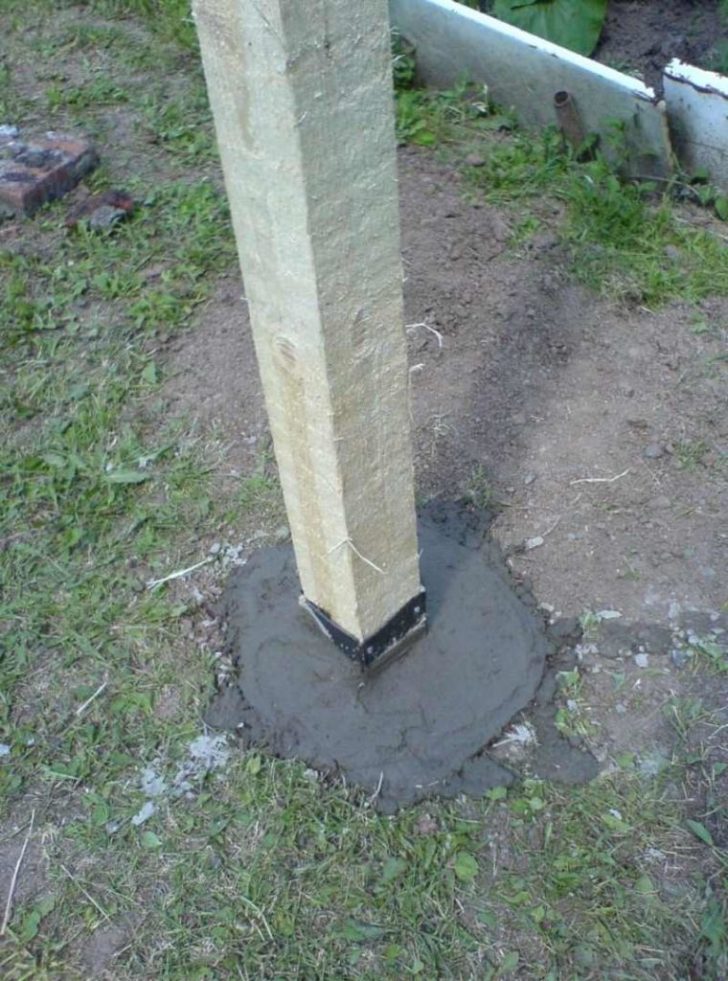
Pole installation
Step 4 We fix horizontal beams. To provide additional strength to wooden pergolas, they are fixed with staples. Conditionally should get a kind of sieve.
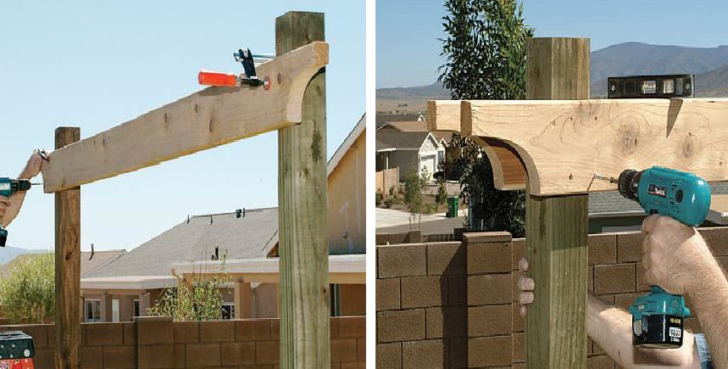
Fixing horizontal beams
Step 5 We lay horizontal beams and sheathe the upper transverse beams. Fixation is carried out with nails driven at a right angle. This moment is important, as it is also responsible for the strength of the structures of garden pergolas.
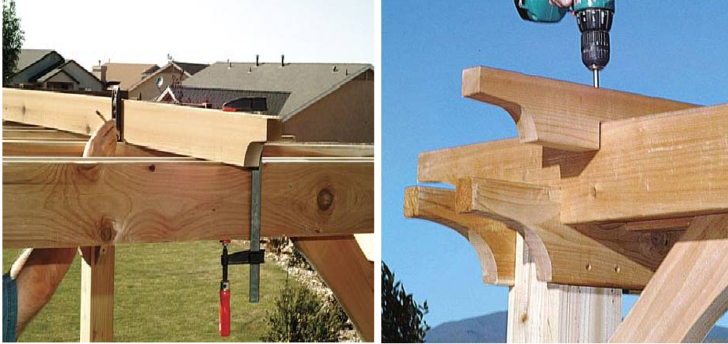
Laying the top beams
Step 6 The last step is optional. Work continues in accordance with the functionality chosen for the pergola. To create a pavilion or screen, the side walls are sewn up with trellis panels. They will serve as a support for the green cover. According to the rules, sheathing panels should not touch the ground. This will keep them from rotting and will not allow wooden pergolas to fail prematurely.
The construction of the pergola with your own hands is completed, now it's time to proceed to the second question.
landscaping
“Designers advise paying attention not only to the landscaping of the pergola itself, but also to the territory adjacent to it”
Planting a building with side bars is easy. This can be done in two ways:
1. Plant weaving plants.
2. Decorate hanging planters with bright colorful flowers.
In both cases, garden pergolas will quickly turn into green tents. On the support beams it is worth putting something from well-wintering vines. It could be yellowleaf hops. Climbing up the pillar, the bush will tightly braid the roof. It must be borne in mind that growing, the plant will become quite heavy, so do not be zealous with the quantity. It is unlikely that the deformation of a do-it-yourself pergola rebuilt is included in your plans. The same restriction applies to grapes. Under it, it is worth building structures of a more monumental type.
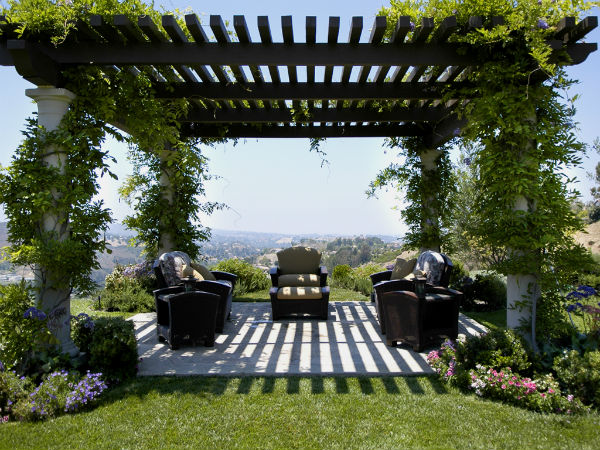
Climbing plants will create shade
Designers advise paying attention not only to the landscaping of the pergola itself, but also to the territory adjacent to it. An aesthetic view should open from the structure. It is good to plant shrubs around the perimeter of the gazebo, and this must be done in such a way that the branches of the latter break through the side gratings. Thus, wooden pergolas will be given volume.
When landscaping, make sure that the riot of greenery does not turn the pergola into a shapeless object. No matter how active the process is, the structure of the building should be clearly visible.Keep the spirit of the art object in it by trimming the plants in a timely manner and directing the growth of their branches in the required direction. Do not let your path lead not to the beautiful far, but to a green cave of unknown origin.
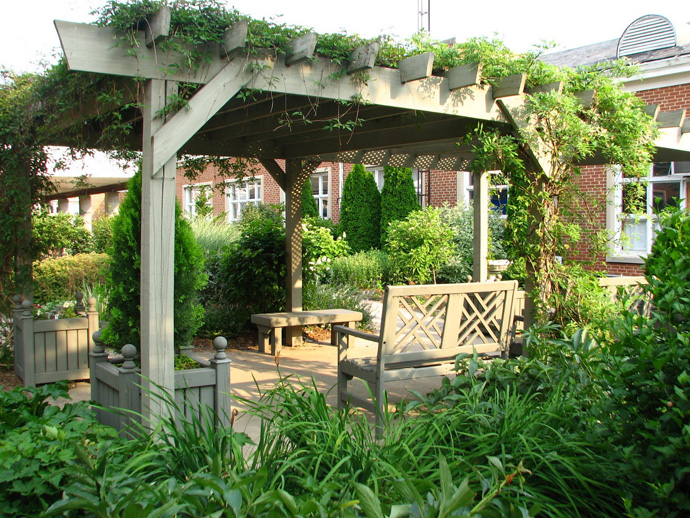
It is necessary to trim the plants regularly so that the pergola does not overgrow.
Alternatives
Instead of wood, you can build a pergola yourself from metal. In the home version, it will be assembled from several arcuately curved reinforcement rods connected by jumpers. Ready-made arches are stuck into the ground without additional strengthening and fixing with a foundation fill.
Profiled pipes can also be recruited for construction, but it will be quite difficult to work with this material on your own. The same can be said about the construction of stone garden pergolas. For independent work on them, at least, you must have the skills of a bricklayer. Add here the high cost of the material, the duration of the process, and the idea will initially seem utopian to you for personal reproduction.
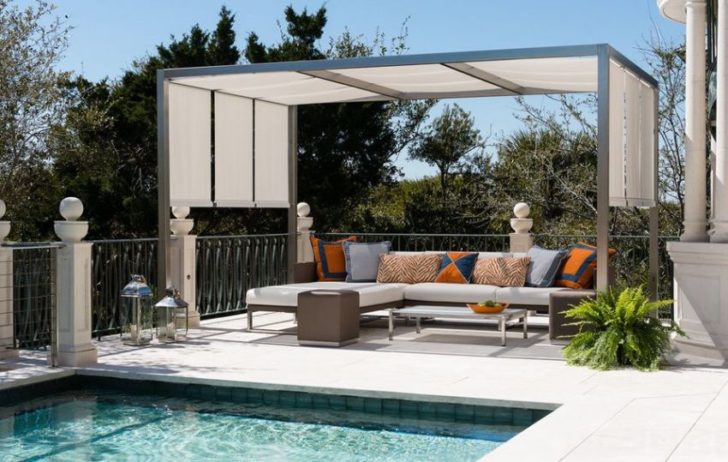
Pergola from profiled pipes
It is even easier to solve the issue of the appearance of a pergola in the garden - to buy it. Today, such elements of landscape design are offered in incredible abundance. You just have to assemble the structure and find a place to install it.
back to index ↑Do-it-yourself pergola construction principles
The construction of such pavilions has a number of nuances, which should not be neglected.
Only a pergola can create a feeling of privacy and absolute peace, which itself looks light and at ease, and this effect must be maintained regardless of the massiveness of the materials used for its manufacture.
The area and height of the structure must correspond to the area of the site. A small pergola will be lost in the wilds of a large garden, and vice versa, a small garden will be lost against the backdrop of a large pergola.

The size of the pergola should match the size of the garden
Garden pergolas must be durable, because fast-growing green mass has a decent weight. In addition, the green pavilion is distinguished by windage, so you should not take risks and stretch it in height. Wooden pergolas above 3 m will definitely not withstand gusts of wind and may collapse. It would not be superfluous to orient such structures according to the wind rose.
In winter, the buildings will be bare, so all the flaws hiding under the greenery will come out. This is a reminder that if you build a pergola with your own hands, then do it honestly. Indeed, in winter, it should also not hit the frame in the dirt and withstand the brand of an art object. Aesthetic pleasure from the contemplation of the pergola should be year-round.
Do not forget about the care of wooden pergolas. They will need protective treatments with antiseptic compounds all their lives, because they can rot due to constant exposure to dampness (rain, watering). The same problem is relevant for metal, only it will need to be protected from corrosion.
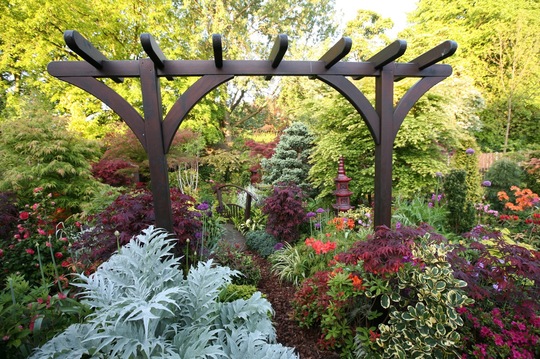
Wooden pergola needs regular maintenance
It does not matter whether you buy sections in a store or assemble a pergola with your own hands - the main thing is that its presence is really pleasing.
back to index ↑Conclusion
It is not difficult to build a pergola with your own hands, while it transforms the site beyond recognition, presenting it from a completely different angle. Treat the process with passion, and you are guaranteed to get an aesthetic and multifunctional object of the garden landscape, conducive to family vacations under shady vaults!
Photo gallery - garden pergola
Video
